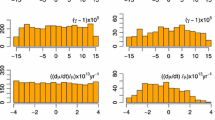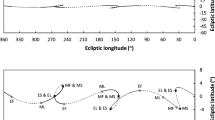Abstract
Modern planetary theories may be considered as a realisation of a four-dimensional dynamical reference frame. The existence of secular trends between the dynamical system and the adopted system of the Fundamental Catalogue (as well as between time scales involved) has been studied by discussing planetary observations of different types and by comparison with a numerical theory constructed for the time span 1769–1988. Parameters of the theory were fitted to radar ranging data for 1961–1988 for inner planets and to meridian observations of 18th–20th centuries for outer planets. Then a set of the inner planet optical observations, which includes USNO meridian observations, transits through the solar disk and occultations of fundamental stars are discussed. The main results are the following:
-
1.
Radar data were used to estimate the time derivativeĠ of the gravitational constantG (in another interpretation, the secular trend between the atomic and dynamic time scales):
$$\dot G/G = (0.37 \pm 0.45) \times 10^{ - 11} /y.$$This estimation, being statistically insignificant, gives some physically meaningful restriction toĠ.
-
2.
From the same data a new estimation of relativistic effects in the motion of Mercury was obtained, which has confirmed the Einstein value of the perihelion advance with the error 0″.06/cy. So in the frame of Einstein's theory the value of solar dynamic oblateness cannot be larger than 2×10−6.
-
3.
The analysis of time behavior of residuals in the inner planet longitudes shows secular trends. It is demonstrated that these trends may be explained by combined action of a linear trenddT of Brouwer's time scale (which is adopted as a standard for reduction of observations before 1959) and the error in Newcomb's value of the constant of precession. From USNO meridian observations fordT the following estimate was obtained:dT=−14.5±2.1 sec/cy with the corresponding correction,dp, to Newcomb's precessiondp=0″.46±0″.13/cy. The estimate ofdT is in good agreement with the value ofdT determined from transits of Mercury and Venus through the solar diskdT=−12.9±1.3 sec/cy which does not depend on any precession error.
-
4.
As a by-product, new accurate ephemerides of the outer planets are obtained over the time interval 1769–1988, the average residuals being presented.
Similar content being viewed by others
References
Asteriadis, C.: 1977, Determination of precession and galactic rotation from the proper motions of AGK3,Astron. Astrophys. 56, 25–31.
Bills, B.G. and Ferrari, A.J.: 1978, Mars topography harmonics and geophysical implications,J. Geophys. Res. B 83, 3497–3508.
Bretagnon, P.: 1982, Theorie du mouvement de l'ensemble des planets. Solution VSOP82,Astron. Astrophys. 114, 278–288.
Canuto, V.M., Hsieh, S.-H. and Owen, J.R.: 1979, VaryingG, Mon. Not. R. Astron. Soc. 188, 829–837.
Charlot, P., Sovers, O.J., Williams, J.G. and Newhall, XX: 1991, A global VLBI/LLR analysis for determination of precession and nutation constants,IAU Coll. 127, Washington, pp. 228–233.
Cohen, Ch.J., Hubbard, E.C. and Oesterwinter, C.: 1967, New orbit for Pluto and analysis of differential corrections,Astron. J. 72, 973–988.
Fricke, W.: 1967, Precession and galactic rotation derived from fundamental proper motions of distant stars,Astron. J. 72, 1368–1382.
Fricke, W.: 1980, On the determination of the equinox and equator of the new fundamental reference coordinate system FK5,Celest. Mech. 22, 113–125.
Fukushima, T.: 1991, Activity report of the IAU working group on reference systems sub-grop on astronomical constants,IAU Coll. 127, Washington, pp. 27–34.
Hellings, R.W., Adams, P.J., Anderson, J.D., Keesey, M.S., Lau, E.L., Standish, E.M., Canuto, V.M. and Goldman, I.: 1983, Experimental test of the variability ofG using lander ranging data,Phys. Rev. Lett. 51, 1609–1612.
Hill, H.A., Bos, R.J. and Goode, P.R.: 1982, Preliminary determination of the gravitational quadruple moment of the Sun from rotational splitting of global oscillations and its relevance to tests of General Relativity,Phys. Rev. Lett. 49, 1794–1797.
Jordi, C. and Rossello, G.: 1987, Corrections to the FK5 reference frame,Mon. Not. R. Astron. Soc. 225, 723–730.
Knox-Shaw, H., Jackson, J. and Robertson, W.H.: 1932, The observations of the Reverend Thomas Hornsby made with the transit instrument and quadrant at the Radcliffe Observatory, Oxford, in the years 1774 to 1798, London, Oxford Univ. Press, 145 pp.
Krasinsky, G.A.: 1985, The obliquity of the ecliptic from occultations of ε Geminorum (1976) and α Leonis by Venus (1959),Bull. Inst. Theoret. Astron. 15, 440–448.
Krasinsky, G.A., Aleshkina, E.Yu., Pitjeva, E.V. and Sveshnikov, M.L.: 1986, Relativistic effects from planetary and lunar observations of the XVIII–XX centuries,IAU Symp. 114, Leningrad, pp. 315–328.
Krasinsky, G.A., Pitjeva, E.V., Sveshnikov, M.L. and Sveshnikova, E.S.: 1978, Analytical theory of the motion of the inner planets AT-1 and its using for ephemeris astronomy problems,Trans. ITA 17, 46–53.
Krasinsky, G.A., Saramonova, E.Yu., Sveshnikov, M.L. and Sveshnikova, E.S.: 1985, Universal time, lunar tidal deceleration and relativistic effects from observations of transits, eclipses and occultations XVIII–XX centuries,Astron. Astrophys. 145, 90–96.
Krasinsky, G.A. and Sveshnikov, M.L.: 1982, Dynamical equinox and analytical theory of the Sun,Celest. Mech. 26, 171–177.
Laubscher, R.E.: 1976, Dynamical determination of general precession in longitude,Astron. Astrophys. 51, 9–21.
Lieske, J.H. and Standish, E.M.: 1981, Planetary ephemerides,IAU Coll. 56, Warsaw, pp. 295–304.
Morgan, H.R.: 1933, Results of observations made with the nine-inch transit circle 1913–1926,Publ. U.S. Naval Obs. 13, 1–96.
Newhall, XX, Standish, E.M. Jr. and Williams, J.G.: 1982, DE102, a numerically integrated ephemeris of the Moon and planets spanning forty-four centuries,Technical Report JPL, California Inst. of Tech., Pasadena, 78 pp.
Nowacki, H. and Strobel, W.: 1968, Systematic relations between 71 star catalogues and FK3 and weights,Astron. Recheninst., Heidelberg,H.21,S., 1–123.
Oort, J.H.: 1943, The constants of precession and galactic rotation,Bull. Astron. Inst. Netherlands 9, 424–427.
Pettengill, G.H., Ford, P.G., Brown, W.E., Kaula, W.M., Masursky, H., Eliason, E. and McGill, G.E.: 1979, Venus: preliminary topographic and surface imaging results from the Pioneer orbiter,Science 205 (4401), 90–93.
Sharaf, Sh.G., Budnikova, N.A. and Chunayeva, L.I.: 1990, Theory of Pluto motion. Part V. Improvement of the Pluto orbital elements,Preprint ITA, Leningrad,3, 13 pp.
Sherman, S.C.: 1978, Mars synthetic topographic mapping,Icarus 33, 417–440.
Standish, E.M. Jr., Keesey, M.S. and Newhall, XX: 1976, JPL development ephemeris number 96,Technical Report 32-1603, JPL, California Inst. of Tech., Pasadena, 36 pp.
Standish, E.M. Jr.: 1982, Orientation of the JPL ephemerides DE200/LE200 to the dynamical equinox of J2000,Astron. Astrophys. 114, 297–302.
Standish, E.M. Jr.: 1990, The observational basis for JPL's DE200, the planetary ephemerides of the Astronomical Almanac,Astron. Astrophys. 233, 252–271.
Standish, E.M. and Williams, J.G.: 1990,Inertial Coordinate Systems on the Sky, in J.H. Lieske, V.K. Abalakin (eds.), Kluwer Academic Publishers, Dordrecht, 173 pp.
Stumpff, P.: 1981, The motion of the Earth-Moon system between 1700 and 2000 in Newcomb's theory and in JPL-Ephemeris,Astron. Astrophys. 101, 52–71.
Sveshnikov, M.L.: 1985, The determination of the FK4 orientation from Washington observations of the Sun and planets,Trans. ITA 19, 31–73.
Thüring, B.: 1975, Neue Bestimmungen der Präzession nach dem Prinzip der Maximalmenge von Sternen ohne messbare Eigenbewegung,Astron. Nach. 296, 23–26.
Will, C.M.: 1981,Theory and Experiment in Gravitational Physics, Cambridge Univ. Press, 341 pp.
Williams, J.G., Dickey, J.O., Newhall, XX and Standish, E.M.: 1991, The orientation of the dynamical reference frame,IAU Coll. 127, Washington, pp. 146–152.
Author information
Authors and Affiliations
Rights and permissions
About this article
Cite this article
Krasinsky, G.A., Pitjeva, E.V., Sveshnikov, M.L. et al. The motion of major planets from observations 1769–1988 and some astronomical constants. Celestial Mech Dyn Astr 55, 1–23 (1993). https://doi.org/10.1007/BF00694392
Received:
Accepted:
Issue Date:
DOI: https://doi.org/10.1007/BF00694392




